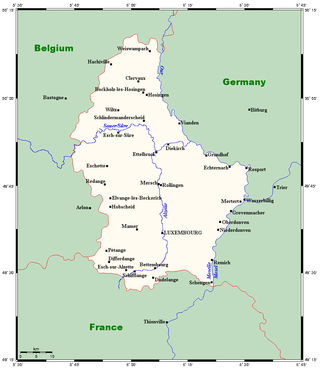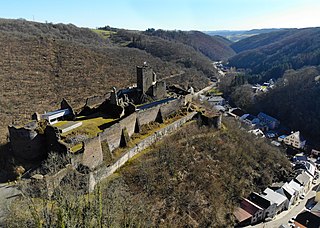
Marbehan is a village of Wallonia in the municipality of Habay, district of Rulles, located in the province of Luxembourg, Belgium.
Contents
The village has around 1000 inhabitants.

Marbehan is a village of Wallonia in the municipality of Habay, district of Rulles, located in the province of Luxembourg, Belgium.
The village has around 1000 inhabitants.
Marbehan lies on the border between Gaume and the Ardennes, it is therefore sometimes dubbed "La porte de la Gaume"[ citation needed ], for its getaway access to the surrounding region. The village lies on the river "Mellier", which flows into the "Rulles" nearby.
The surrounding villages are Mellier to the north, Rulles and Villers-sur-Semois to the east, Harinsart and Ansart/Tintigny to the south, and Rossignol and Orsinfaing to the west.
The surroundings of the village mainly consist of farmland, marshland around the 'Mellier', and the Ardennes forest.
Marbehan counts a number of different stores and two factories. One of them called Lambiotte S.A. produce chemicals and the other one called Trabelbo S.A. is an industrial carpentry.
The village has a railway station on the line IC 162 Brussels-Luxembourg of the SNCB network. Marbehan is also served by many buses from the TEC. The E411 highway nearest exit is a mere two kilometers from the village.
There are two primary and maternal schools in the village.

Luxembourg is a small country located in the Low Countries, part of North-West Europe It borders Belgium for 148 kilometres to the west and north, France (73 km [45 mi]) to the south, and Germany (138 km [86 mi]) to the east. Luxembourg is landlocked, separated from the North Sea by Belgium.

Luxembourg, also called Belgian Luxembourg or West Luxembourg, is the southernmost province of Wallonia and of Belgium. It borders on the country of Luxembourg to the east, the French departments of Ardennes, Meuse and Meurthe-et-Moselle to the south and southwest, and the Walloon provinces of Namur and Liège to the north. Its capital and largest city is Arlon, in the south-east of the province.

The Ardennes, also known as the Ardennes Forest or Forest of Ardennes, is a region of extensive forests, rough terrain, rolling hills and ridges primarily in Belgium and Luxembourg, extending into Germany and France.

Bastogne is a city and municipality of Wallonia located in the province of Luxembourg in the Ardennes, Belgium.

Chiny is a city and municipality of Wallonia located in the province of Luxembourg, Belgium.

Les Bulles is a village of Wallonia and a district of the municipality of Chiny, located in Gaume in the province of Luxembourg, Belgium.

Gaume is a region in the extreme southeast of Belgium. At a lower altitude than the Ardennes, it borders the French region of Lorraine to the south, the Land of Arlon to the east, and the Belgian part of the Ardennes to the north.

Orval Abbey is a Cistercian monastery founded in 1132 in the Gaume region of Belgium and is located in Villers-devant-Orval, part of Florenville, Wallonia in the province of Luxembourg. The abbey is well known for its history and spiritual life but also for its local production of the Trappist beer Orval and a specific cheese.

Hamm is a quarter in eastern Luxembourg City, in southern Luxembourg. It is the home of the Luxembourg American Cemetery and Memorial, the final resting place of 5,076 American servicemen, including General Patton.

Wiltz is a commune with town status in north-western Luxembourg, capital of the canton Wiltz. Wiltz is situated on the banks of the river Wiltz. It was also a battleground in the Battle of the Bulge, near the end of World War II. A local airfield was used by both sides of the conflict, depending on the location of the Front.

Born is a village on the River Sauer in the commune of Mompach, in eastern Luxembourg. It lies on the N10, 14 km (9 mi) south of Echternach and 8 km (5 mi) north of Wasserbillig. Only 5 minutes drive from the E44 motorway from Luxembourg City to Trier, it is popular with tourists and day-trippers who walk, cycle or fish along the banks of the river.

The Duchy of Luxemburg was a state of the Holy Roman Empire, the ancestral homeland of the noble House of Luxembourg. The House of Luxembourg, now Duke of Limburg, became one of the most important political forces in the 14th century, competing against the House of Habsburg for supremacy in Central Europe. They would be the heirs to the Přemyslid dynasty in the Kingdom of Bohemia, succeeding the Kingdom of Hungary and contributing four Holy Roman Emperors until their own line of male heirs came to an end and the House of Habsburg got the pieces that the two Houses had originally agreed upon in the Treaty of Brünn in 1364.

Athus is a part of Aubange city Wallonia and a district of the municipality of Aubange, located in the province of Luxembourg, Belgium.

Achouffe is a small village of Wallonia in the municipality of Houffalize, district of Wibrin, located in the province of Luxembourg, Belgium.

Margut is a commune in the Ardennes department in northern France.

The Bock is a promontory in the north-eastern corner of Luxembourg City's old historical district. Offering a natural fortification, its rocky cliffs tower above the River Alzette, which surrounds it on three sides. It was here that Count Siegfried built his Castle of Lucilinburhuc in 963, providing a basis for the development of the town that became Luxembourg. Over the centuries, the Bock and the surrounding defenses were reinforced, attacked, and rebuilt time and time again as the armies of the Burgundians, Habsburgs, Spaniards, Prussians, and French vied for victory over one of Europe's most strategic strongholds, the Fortress of Luxembourg. Warring did not stop until the Treaty of London was signed in 1867, calling for the demolition of the fortifications. Ruins of the old castle and the vast underground system of passages and galleries known as the casemates continue to be a major tourist attraction.

The Land of Arlon is the traditionally Luxembourgish-speaking part of Belgian Lorraine, which is now predominantly French-speaking. Arlon is the main city of this region.

Belgian Lorraine is the part of Lorraine that lies in the south of the Belgian province of Luxembourg, in Wallonia.

Brandenbourg Castle, now a ruin, is located on a promontory some 70 metres above the village of Brandenbourg in north-eastern Luxembourg. It has a history going back to the 9th and 10th centuries when there was a wooden fort on the site. The 13th century keep, now 11.9 metres high, used to have four floors, only three of which remain. Around 1687, the French destroyed the external walls of the castle which subsequently fell increasingly into ruin. It is now owned by the family du Fays - van Delft. The owner signed an emphyteutic lease (1997) with the State of Luxembourg permitting the state to take care of the castle.

Grand Est is an administrative region in northeastern France. It superseded three former administrative regions, Alsace, Champagne-Ardenne and Lorraine, on 1 January 2016 under the provisional name of Alsace-Champagne-Ardenne-Lorraine, as a result of territorial reform which had been passed by the French Parliament in 2014.